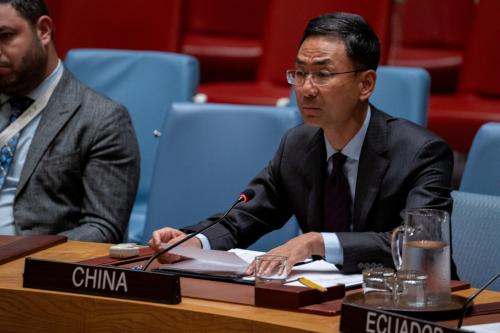Executive summary
 For two decades, China sought to profit from key arrangements of the global political and economic order. Now, in several (though not all) domains, China seeks to subvert these long-standing arrangements and prevent the emergence of new ones, in order to broaden its scope for action. It has also started to propose new arrangements under Chinese diplomatic leadership, starting to seek a role as an ordering power. In response, the United States and its Western allies must adapt their strategies. That does not mean refusing to cooperate with China in areas of common interest (for example, nonproliferation); but in most domains, the United States must not just look to the leading democracies but also to a wider constellation of states willing to act in defense of the core purposes of the order.
For two decades, China sought to profit from key arrangements of the global political and economic order. Now, in several (though not all) domains, China seeks to subvert these long-standing arrangements and prevent the emergence of new ones, in order to broaden its scope for action. It has also started to propose new arrangements under Chinese diplomatic leadership, starting to seek a role as an ordering power. In response, the United States and its Western allies must adapt their strategies. That does not mean refusing to cooperate with China in areas of common interest (for example, nonproliferation); but in most domains, the United States must not just look to the leading democracies but also to a wider constellation of states willing to act in defense of the core purposes of the order.
Introduction
A rising power may shape its own ambition, but not just as it pleases; it does not choose the world into which it will rise.1 The balance of power in its region, the overall international balance, and simple geography are inescapable factors that shape a country’s choices as it grows. Other factors include the structure of the global economy, access to natural resources, and the sources of international finance.
Much recent discourse on the challenge of China’s mounting power has been focused on the military and technological balance and on the growing tensions between China’s burgeoning military capability and America’s forward presence in Asia. And to be sure, China’s rapid buildup of its navy and supporting technologies reveal the country’s preoccupation with increasing its freedom of maneuver in the Taiwan Strait and the wider reaches of the Western Pacific and beyond.2
But China is asserting itself in a world heavily shaped by extensive globalization (which enabled China’s economic rise) and a global political order underpinned by a treaty-based system. Contemporary globalization is characterized by massive trade and investment flows between the major economies of all regions, with China playing the role of the intermediate manufacturing node for the global economy (much of which is regulated by a set of well-articulated institutions) while remaining heavily dependent on imported resources and global financial flows. Encompassing this economic order but extending beyond it, the global political order is characterized by patterns of behavior or arrangements between leading states, codified in treaties and often observed by institutions. Just as China is actively engaged in an arms race in the Western Pacific, it is also engaged in a race for position and influence in the global order.3
There are myriad policy domains that have corresponding established treaties, institutions, and agreed rules that aim to “guide” state behavior — a more accurate term than “govern.” Many are of modest consequence to overall international prosperity and stability. But a handful are far more consequential—for example the treaties that stipulate sovereign equality and freedom of navigation.
These treaties and institutions shape, to some degree, the policies and expectations of leading players on the world stage. The leading states in the international system are not compelled by the treaties and institutionalized arrangements of the existing order, but rather choose to follow them (to some degree) for the reciprocal benefits they can provide — until they chose not to. Smaller or weaker states have fewer options. As China has grown from a weak state to a strong one, it is starting to exploit the stronger powers’ ability to pick and choose when and where to comply with core treaty provisions, as well as to shape the next generation of consequential treaties — in technology and climate, for example.
* * *
For as long as China has been an aspiring or rising power, the global order has been shaped and dominated by the liberal powers. From the mid-1990s until midway through the administration of former President Donald Trump, the United States and its Western allies engaged in what might best be described as a half-hearted effort to bring China more deeply into the fold of the established political and economic order and the institutions of global governance. This involved bringing China into the World Trade Organization (WTO), creating a “+5” mechanism on the margins of the G-7, and later creating the G-20 — partially out of a sense that doing so would moderate and influence the rising power’s ambitions.4 Whether a more full-throated effort, including incorporating changes to the security order in Asia and allowing for greater Chinese voice in the international financial institutions, would have had that effect is debatable. But that ship has sailed. In fact, China’s behavior and its role within those existing institutions it has inhabited suggests the opposite; a more expansive opening to China would have led to a deeper erosion of the global order’s established arrangements.
China’s overarching strategy for the past decade and more has been to lessen the hold of the liberal powers on the institutions and arrangements of the global order (as well as to shift the balance of military power). For that broad goal, China has considerable international support, certainly in the Global South but also among other rising powers, even those who view China’s growing military power as a threat. But in some domains, it now seems that China may be seeking to overturn, or at least subvert, key pillars of the order itself.
-
Acknowledgements and disclosures
The authors are grateful to Jeffrey Feltman, Alexandre Marc, and Constanze Stelzenmüller for their substantial input and comments on the draft of this paper, and for comments on an initial draft by Ryan Hass and Patricia Kim. Research support was provided by Sophia Hart, and graphics support by Rachel Slattery.
-
Footnotes
- In the late 19th century, the United States, at its moment of economic ascendancy, faced an enviable international situation — characterized by the absence of neighboring powers, a Europe distracted by internal struggles, a rising Asian power (Japan) that sought positive relations with the West, huge reserves of natural resources, and easy access to the seas. By contrast, Russia and Germany, at various points in their history, faced far less favorable conditions, including powerful neighbors, import dependencies, and constrained access to the seas.
- John Culver, “How We Would Know When China Is Preparing to Invade Taiwan,” Carnegie Endowment for International Peace (October 3, 2022), https://carnegieendowment.org/2022/10/03/how-we-would-know-when-china-is-preparing-to-invade-taiwan-pub-88053.
- Two recent pieces suggest that the existing order is already rent and propose new pathways forward; both pieces suggest three core elements of order, encompassing economic, strategy and global issues. They diverge on a key question, which this essay addresses: can we still anticipate some degree of Chinese cooperation in a (reformed) order? See Steven Walt and Dani Rodrik, “How to Build a Better Order: Limiting Great Power Rivalry in an Anarchic World,” Foreign Affairs, September/October 2022, https://www.foreignaffairs.com/world/build-better-order-great-power-rivalry-dani-rodrik-stephen-walt; see Philip Zelikow, “The Hollow Order: Rebuilding an International System That Works,” Foreign Affairs, July/August 2022, https://www.foreignaffairs.com/articles/world/2022-06-21/hollow-order-international-system.
- In the global financial crisis, this worked: China collaborated with the West to abate the crisis and pushed back on Russian ideas for amplifying it. See inter alia Daniel W. Drezner, The System Worked: How the World Stopped Another Great Depression (Oxford University Press, 2014).
The Brookings Institution is committed to quality, independence, and impact.
We are supported by a diverse array of funders. In line with our values and policies, each Brookings publication represents the sole views of its author(s).










